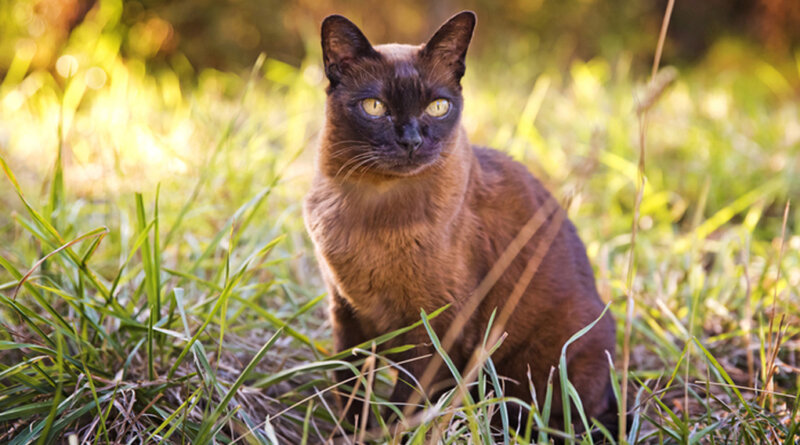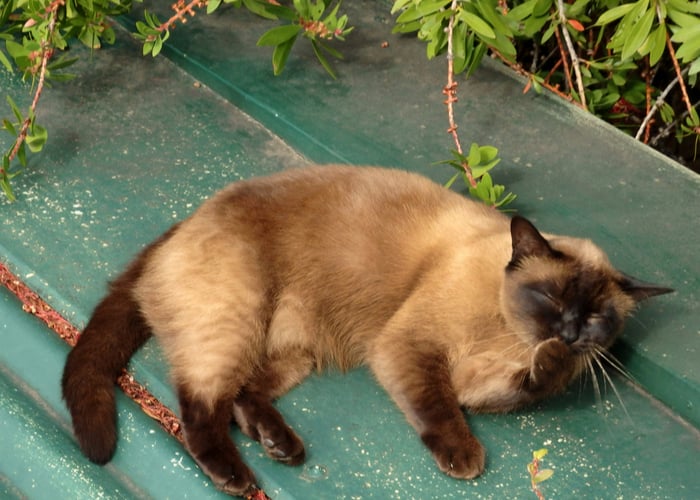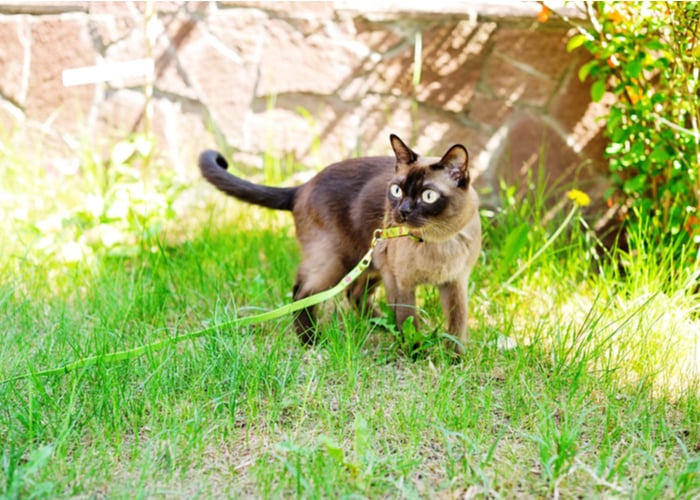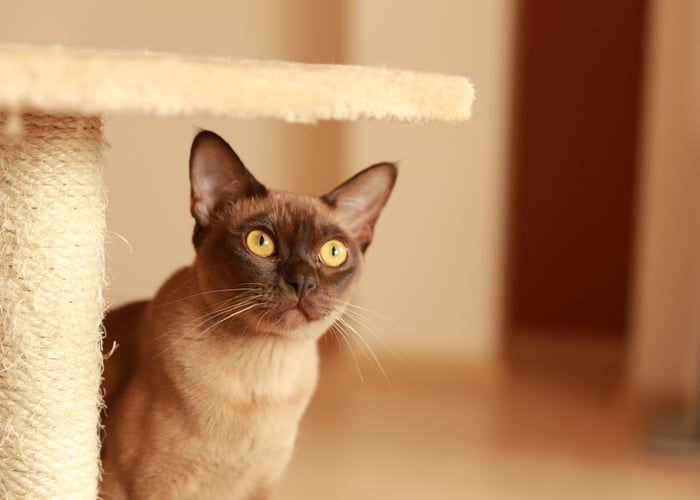Characteristics, History, and Grooming Tips
The first time you see a Burmese Cat Breed, we bet you’ll get lost on its charming, golden eyes.
If not, its friendly and affectionate personality, glossy and satin-like coat, and muscular build will get you smitten.
But you might wonder, is it the right feline companion for you?
In this article, we’ll unmask Burmese Cats and reveal their:
- True colors and describe their physical attributes
- History and their most common health problems
- Lifespan and tips on how to prolong it
- Average cost and where you can find them
If you have trouble weighing in if Burmese cat will fit your personality and lifestyle, this detailed discussion can help you.
But before all of that, let us show you what type of cat we are talking about today and how it looks.
Physical Attributes of Burmese Cat Breed
Burmese cats have distinctive physical traits, from their head down to their paws. Let us discuss it one by one.
HEAD
Whether you look at it from the front or side, its head is pleasingly rounded with no flat planes.
There’s an ample breadth between their eyes, but it subtly complements their broad and well-developed snout that keeps their head’s rounded contours.
Their chins are well-rounded, indicating a good bite and their head rests on a well-developed neck.
Every feature in their heads complements perfectly. So other cat owners aren’t lying when they say Burmese cats are beautiful.
BODY
Burmese cats may appear sleek and petite, but don’t be fooled by it. They’re actually compact and have a muscular build.
So, even if they’re medium-sized, they weigh heavier than they look. You can also see large-sized Burmese on males.
They also have a profuse, rounded chest, and their back is leveled from shoulder to tail.
EARS
The ears of these cats are one of the reasons why they have an alert appearance.
Their ears are medium-sized, well-set apart with a broad base and rounded tips and tilting slightly forward.
EYES
Their large eyes with rounded aperture are set far apart and usually gold, if not green in color. It’s so hypnotic, and it makes them look more sophisticated.
LEGS, PAWS & TAIL
Their legs are well-proportioned to their body while their paws are round, and they have five toes in front and four in their hind legs while their tails are medium-length and straight.
COAT TEXTURE & COLOR
Their elegant coat has glossy, satin-like textures that are short and close lying.
Due to their solid and muscular body and beautiful coat, people describe them as “brick wrapped in silk.’
Every association has specific standards for Burmese cat’s coat color and points assigned to each characteristic. Let’s about each one of them.
Breed Standards for Burmese Cat’s Coat:
The Cat Fanciers’ Association (CFA)
CFA, an organization for felines in America, acknowledges four colors of Burmese cats.
And each color comes with a standard nose leather and paw pad color.
- Sable – rich dark brown coat comes with brown nose leather and paw pads
- Platinum – pale gray coat with fawn undertones and lavender-pink nose leather and paw pads
- Champagne – warm beige coat complemented with light brown nose leather plus pinkish-tan paw pads
- Blue – a medium gray coat color with fawn undertones and slate gray nose leather plus slate gray to pinkish-blue paw pads
The Governing Council of the Cat Fancy (GCCF)
The Governing Council of the Cat Fancy, an organization that registers pedigreed cats in the UK, recognizes ten colors of Burmese cats:
- red
- cream
- blue
- lilac
- brown
- chocolate
- blue tortoiseshell
- brown tortoiseshell
- chocolate tortoiseshell
- lilac tortoiseshell
The International Cat Association (TICA)
TICA, the largest international cat registry of pedigreed cats, acknowledges a range of Burmese cat colors, including:
- rich, dark sable brown
- a medium, warm blue
- a warm, honey beige chocolate coat with pink or fawn tints
- a lilac with tones ranging from a bright pinkish grey to silvery platinum added with pink tints
- reds of a light, golden apricot that comes with melon-orange overtones
- rich, warm deep creams with shades of apricot
- a soft blend of red or cream with sable, blue, chocolate, or lilac found in the tortoiseshells
The Personality of Burmese Cat Breed
Burmese cats are generally friendly, energetic, and as charming as their Siamese ancestors.
Their playful side extends from kittenhood to adulthood.
Since they’re so active, they suit families with an active lifestyle and willing to play and interact with pets.
Their devotion to their humans is similar to dogs, and they enjoy talking to their owners with a soft and sweet voice.
They love following and cuddling with their owners while watching TV, preparing in the kitchen, working on a computer, or during meetings.
They’re also curious cats; they’re fond of exploring every nook and crane in your home. So if you don’t mind losing your privacy, they’re fit for you.
Difference Between Male and Female Burmese
There’s a slightly noticeable difference between male and female Burmese personalities. You may not notice it at first, but as you get to know them, you’ll see how they act differently.
Female Burmese Cat’s Personality
Females are queenly and sometimes bossy because they like to be in charge of everything, and they love receiving attention.
Male Burmese Cat’s Personality
Male Burmese are into sleeping, and they like to supervise from the comfort of a lap.
The downside of Burmese cats is that when they become deeply attached to their humans, they’ll get depressed if left alone in your home for a long time.
But, here are…
Tips on how to entertain them:
- Give him another Burmese pal that will keep him company
- Tease his intellect with interactive toys like puzzles
- Provide a tiny ball he can play with
If you have the luxury of time, teach him tricks like sitting, fetching a toy, rolling over, and walking on a leash.
These kinds of training can make car rides and vet visits a breeze.
History of Burmese Cat Breed
Burmese cats descended from a chocolate-colored cat named Wong Mau brought to America from Rangoon Burma(now called Yangon, Myanmar) by a sailor in 1930.
She was given to a Siamese breeder, Dr. Joseph Thompson of San Francisco.
He described Wong Mau as a small cat with fine bone and a more compact body than a Siamese.
It also has a shorter tail, rounded and short-muzzled head with more considerable breadth between their round eyes.
First Burmese Cat Breeding
Since he’s enthralled by Burmese’s chocolate brown color with seal brown or nearly black points, he started a breeding program.
He collaborated with breeders Virginia Cobb and Billie Gerst and geneticist Dr. Clyde E. Keeler of Harvard University.
They bred Wong Mau with a seal-point male Siamese named Tai Mau.
Their offspring varied in colors; some were beige, others looked like the Siamese, while others resembled Wong Mau herself.
However, Dr. Thompson discovered in the process that Wong Mau herself is half-Siamese and half-Burmese.
They also learned that the pointed pattern is a recessive trait, so to have that pattern, a cat must receive a copy of that gene from both parents.
Since Wong Mau possesses that pattern, they mate her with her brown-colored kitten with dark points.
Their offspring have three different looks — a Siamese, dark brown with points, and a dark brown with no points.
The dark brown kittens with no markings became the foundation of the Burmese cat breed.
Later research revealed that the Burmese gene responsible for the sable color belongs to the albino gene family.
The Burmese gene makes solid black appear dark sable brown by lowering the quantity of pigment in the hair.
Registration of Burmese Cat Breed
The Cat Fanciers Association (CFA) started registering Burmese breeds in its studbook in 1936.
But CFA suspended the registration between 1947 to 1953 because breeders kept crossing Burmese with Siamese.
This practice later led to the development of the Tonkinese breed.
The registration resumed in 1953 when they stopped the crossbreeding practice, and the breed became fully recognized by CFA in 1957.
Caring and Grooming Tips for Burmese Cat Breed
Having a grooming routine is vital to keep your Burmese cat looking gorgeous. Here are some tips on how to groom them and keep them clean:
Cleaning Tips for Ears
Burmese’s ears need weekly cleaning. If you spot some dirt on them, you may wipe them out using a cotton ball or soft cloth.
But, it would be best to dampen it with a 50-50 mixture of cider vinegar and warm water first.
It can help treat infestations and has anti-bacterial and anti-fungal properties.
Cotton swabs may damage the interior of their ears, so you have to avoid using them.
Cleaning Tips for Eyes
Your feline’s eye also needs cleaning. You may use a soft, damp cloth to remove any discharge in it.
Keep in mind that you must use a separate area of the cloth for every eye to avoid spreading infection.
It would be best to talk with your veterinarian if you see any signs of discomfort in his eyes to make sure he’s not suffering from a particular eye condition.
Brushing Tips for Their Teeth
Daily brushing is vital for cats to prevent periodontal disease caused by plaque build-up.
But if it’s not possible, brush its teeth at least once a week.
Consulting veterinarians is also essential to ensure they can have the best oral health.
They can conduct examinations and cleaning that can keep their teeth and gums healthy.
Coat Grooming Tips
Burmese cat’s coat is easy to maintain since it’s soft and short and doesn’t shed much.
All it needs is brushing or combing to remove the dead hair and distribute the skin oil.
Bathing is rarely necessary for these breeds. So, keeping its coat immaculate doesn’t need much time and effort.
Maintenance Tips for Litters
Like all felines, Burmese cats are very particular about bathroom hygiene, so you have to keep your pet’s litter box spotlessly clean all the time.
Common Health Problems of Burmese Cat Breed
Burmese people are typically healthy. However, just like other cat breeds, they can inherit diseases.
That’s why breeders should provide a written health guarantee on kittens.
Claims that say their Burmese kittens are 100% healthy and have no known problems are unrealistic.
These are the health conditions you should be aware of:
Hypokalemia (or hypokalemic polymyopathy)
Burmese cats can develop hypokalemia – an inherited illness caused by low potassium levels in the blood, which results in skeletal, muscular weakness.
A cat may suffer from episodes of extreme muscle weakness due to this condition.
It can lead to temporary paralysis in the neck or limbs or affect the whole body.
Affected cats typically have walking problems and struggle to hold their head correctly.
DNA tests can help to know if a cat carries the disease. Giving your cat potassium supplements can also help to treat it.
Other health problems that affect Burmese cats are the following:
Glaucoma
This eye condition is characterized by increased intraocular pressure and can result in blindness in cats.
It is also excruciatingly painful, but vets can treat it with drugs that help lower intraocular pressure and prevent retinal and optic nerve damage.
Severe cases may need hospitalization and surgery to remove the affected eye.
Lipemia
This condition causes the cat’s eye to appear milky during kittenhood, but it usually resolves independently.
Kidney stones
This condition rarely happens to cats. However, if a stone blocks the feline’s ureter, it can cause vomiting and depression. The cat may also suffer from pain in the abdomen area.
The treatment includes surgery, special diets, and lithotripsy, which refers to breaking the stones apart using sound waves.
Diabetes mellitus
It’s an endocrine problem caused by a defect in insulin secretion or inaction, leading to increased sugar levels in the blood.
Corneal dermoid
This rare congenital disability is characterized by hair growth on or near the cornea or in the cat’s conjunctiva, which is the white of the eye.
Vets usually correct this condition by surgery.
Cranial deformities
This Burmese head defect occurs when the cat’s skull shape becomes abnormal due to the bones not expanding, usually with the brain’s growth.
Elbow osteoarthritis
It’s an early onset of arthritis in the elbow and limits the Burmese cat’s activity or mobility.
Non-drug treatment for this condition includes increased exercise and weight loss for overweight cats.
Dilated cardiomyopathy
This condition is rare in cats, but affected cats generally have a short lifespan of six to eight months.
Its cause was linked to a taurine deficiency that causes enlargement of the heart.
Orofacial pain syndrome
When the cat licks, chews, and paws at its mouth in an exaggerated manner, these could be symptoms of orofacial pain syndrome.
This discomfort worsens when a cat is excited or under stress and will prevent him from eating because it’d be painful for him.
Some cases naturally resolve while others recur. Good thing pain medications and anti-seizure drugs can ease the discomfort.
Endocardial fibroelastosis
It is a disorder in which the heart’s left ventricle thickens, thus causing the heart muscle to stretch.
Signs usually appear between the ages of 3 weeks and four months, which is why it’s best to wait until the kitten turns four months old before bringing it home.
Flat-chested kitten syndrome
This condition is the deformity in Burmese kitten’s chest caused by lung collapse that ranges from mild to severe.
When kittens survive to adulthood, they frequently show no traces of their survival.
Feline hyperesthesia syndrome
If a cat has extreme sensitivity in some area of its skin, it could indicate that it suffers from hyperesthesia.
Clinical signs often include aggression towards people, other animals, dilated pupils, and vocalization and salivation.
Congenital peripheral vestibular disease
Head tilting, poor balance, fast eye movements, and clumsy walking are symptoms of this condition in kittens.
Those who suffer from this disease may also become deaf.
The Lifespan of Burmese Cat Breed
Burmese cats are among the longest-living cat breeds. Its life expectancy ranges from sixteen to eighteen years.
So, if you’re looking for a long-living companion, this breed might be the one for you.
But to maximize their lifespan, you need to provide your cat the best possible nutrition.
It would also be best to keep Burmese cats an indoor-only pet to protect them from diseases and infections spread by other felines.
By keeping them inside your home, you can protect them from accidents as well, like being hit by a car and attacks perpetrated by dogs or coyotes.
Burmese cats roaming around outside are also at risk of getting stolen by someone who wants a gorgeous pet without spending a dollar.
Since they’re extroverts who are extremely trusting even to strangers, they can easily fall into a predator’s trap, and they’re prone to catnapping.
Diet and Nutrition Tips for Burmese Cats
Burmese cats need lots of protein and nutrients due to their active lifestyle.
It’s also vital to provide high-quality dry food to your feline pet because it is beneficial for oral health.
And you can also supplement it with wet food if you prefer.
Diet can be a problem, though, if your cat is a picky eater.
So, the National Alliance of Burmese Breeders recommends switching brands of cat food now and then.
It can help prevent your pet from becoming accustomed to just one kind of food.
However, to ensure that all your cat’s dietary needs are being met, it would be best to consult a veterinarian about different diet options.
Where Can You Find Burmese Cats?
Before getting one, you need to do some homework to ensure your Burmese is healthy and well-mannered.
You also have to think about what suits your lifestyle better – a kitten or adult cat.
Kittens are adorable and fun, but it takes a lot of work and time to raise them, and they tend to get destructive until adulthood.
On the other hand, you’ll know what their personality and health status are when they’re already adults.
So, others prefer adult cats, especially the retired show or breeding cat with good temperament and performance.
It takes time and effort to do research, but if you’d do it, just like when you’re choosing an expensive car or appliance, it can save you a significant amount in the long run.
Here are two ways to get a Burmese cat:
Purchasing from a Burmese Cat Breeder
You can buy a Burmese cat from reputable breeders in your local area.
Reputable breeders are those who follow the code of ethics that prohibits sales to pet stores and wholesalers.
They should also define their responsibilities to their cats and buyers and conduct health certifications to ensure the felines are free from genetic diseases.
Many reputable breeders have websites, but how will you know who’s and whos’ not?
Here are the…
Red flags you should be aware of:
- If the cat is always available
- If there are multiple litters on the premises
- And if they offer a credit card payment option…
Beware of them because even if those ways are convenient, they’re often not associated with trustable breeders.
You can ask your veterinarian, too, if there are reputable breeders or rescue organizations in your area.
If there’s none, here’s another option for you.
Adopting from a Burmese Rescue or Shelter
Sometimes, pedigreed cats end up in shelters or rescue organizations when they lose their home due to an owner’s death, divorce, or financial difficulties.
You can find Burmese cats that are up for adoption on these reputable websites:
Other than those organizations, social media can also help you find a Burmese cat.
It would help if you’d ask for recommendations from your vet too.
And if ever you found one, it’s crucial to ask questions about the cats:
- energy level
- age and health conditions
- personality around other animals, workers, visitors, and children
- litterbox training
- history of biting or scratching someone they know of
No matter where you got your Burmese cat from, you shouldn’t forget to create a contract with the seller, shelter, or rescue organization.
It should detail out the responsibilities of both sides.
And if you bought your car in a state with Pet Lemon Laws, you need to be aware of your rights and recourses too.
How Much Does a Burmese Kitten Cost?
Burmese kittens cost anywhere between $600 and $1,000, depending on their color, temperament, and abilities.
If you’re looking to buy from famous breeders, you can expect to pay a higher price tag, with costs ranging from $1,200 – $2500 per kitten.
It’s hefty, but it’s worth it if your Burmese has an excellent pedigree, superb appearance, or performing ability because they’ll excel in cat shows and will produce outstanding offspring.
However, you have to be aware that the cost of cat ownership goes beyond the initial purchase price.
Therefore, it’d be best to calculate the daily and monthly expenses first before making the purchase.
Burmese Cat Name Ideas
After purchasing or adopting a Burmese cat, the next step is to name your pet.
If you’re having a hard time coming up with a name for your Burmese cat, here are some ideas to help you out.
Burmese Kitten Names
Picking a name for a kitten is a privilege because it may be the first and only name they’ll ever know.
Here are some lovely names for adorable Burmese kittens in your home:
- Alice
- Hershey
- Jasmine
- Star
- Velvet
- Cloud
- Hansel
- Asia
- Alley
- Percy
Male Burmese Cat Names
When choosing a name for male cats, you can either go for a masculine or adorable one.
You may also name it base on its personality.
Here’s our collection of Burmese cat names you may choose from:
- Damian
- Ezra
- Jackson
- Nigel
- Nyx
- Orion
- Theo
- Arthur
- Mitchel
- Harrison
Female Burmese Cat Names
There are endless possibilities when naming a female cat, and we’ve collected some of them that might suit your pet below:
- Athena
- Bella
- Diva
- Duchess
- Nala
- River
- Shadow
- Trixie
- Venus
- Zia
Chocolate Burmese Cat Names
In case you want to name your feline based on its chocolate color, here are some ideas for you:
- Ashen
- Brunette
- Chestnut
- Fudge
- Heath
- Hazel
- Latte
- Maple
- Truffle
- Whisky
Blue Burmese Cat Names
If your Burmese cat has a blue coat, you might find these names well-suited for your pet:
- Archer
- Ash
- Blossom
- Cleo
- Cyan
- Grey
- Midnight
- Rain
- Stormy
- Sky
Our Final Thoughts About Burmese Cat Breed
Burmese cats overflow with energy and charm; no wonder many cat owners fell in love with them.
But, of course, they all come with a cost, and there are things you need to understand and be aware of as an owner.
To sum it up, these are the pros and cons of Burmese cats.
Pros:
- They’re affectionate, intelligent, attentive, and loyal extroverts.
- They have a longer lifespan.
- They’re kid-friendly, and they get along with other cats or dogs well
- They don’t shed much
- They’re active, energetic and easy-to-train
- They have minimal grooming needs
Cons:
They’re prone to a hereditary muscular disease called hypokalemia
- They tend to be demanding and bossy
- They’ll get depressed if left alone for a long time.
- This breed is highly trusting even with strangers.
Overall, we believe that the pros can outweigh the cons of the Burmese cat breed as long as you’ll make sure it is healthy and comes from a reputable breeder.
If you want to consider other popular breed options before making the final decision, the article below can help you.
READ NEXT: Popular Cat Breeds for Feline Lovers















I don’t unremarkably comment but I gotta tell regards for the post on this one : D.
I love your writing style really enjoying this site.
I believe other website owners should take this website as an example , very clean and excellent user genial pattern.
I just like the helpful info you supply in your articles. I’ll bookmark your weblog and test once more right here frequently. I am relatively sure I will be told a lot of new stuff right right here! Best of luck for the following!
I like what you guys tend to be up too. Such clever work and reporting! Keep up the fantastic works guys I’ve you guys to my personal blogroll.
buy kamagra online usa https://kamagra.icu/# – Kamagra Oral Jelly